
Mexico Journal II – The Pyramids of Teotihuacán
Pictorial report by Frederic Friedel
Teotihuacán, the goal of an excursion arranged for journalists and dignitaries
on one of the free days, is the largest pre-Columbian city in the Americas.
The city, located approximately 40 km (25 miles) northeast of Mexico City, reached
its zenith between 150 and 450 AD, when it was the center of a powerful culture
whose influence extended through much of the Mesoamerican region. At its height
the city covered over 30 km² (over 11 square miles), and probably housed
a population of over 150,000 people, possibly as many as 250,000.
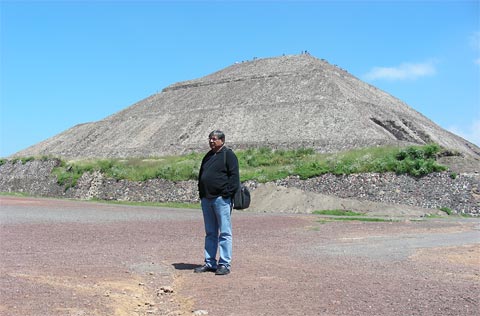
Our video partner Vijay Kumar from India pauses (and poses) in front of
the giant "Pyramid of the Sun", the second largest in the New World,
after the Great Pyramid of Cholula.
During the 7th or 8th centuries the city was sacked and burned by invaders,
or possibly destroyed in an internal uprising. In any case the decline of Teotihucán
has been correlated with the droughts related to the climate changes of 535
– 536 AD. So this, apparently, is not just a problem of our time.
Before we can embark on our expedition to these monumental structures, and
actually scale them, there is some vital equipment we need to procure: protection
from the sun that is ruthless at an altitude of two and a half kilometers.
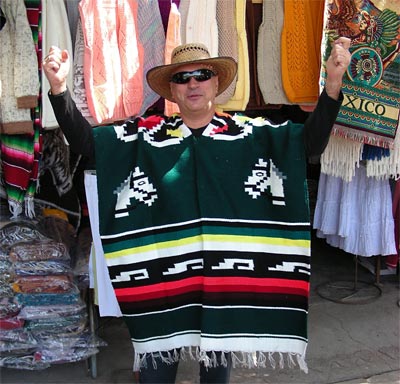
FIDE vice president Zurab Azmaiparashvili goes for a hat and a poncho, which
can be purchased at the bus station at the base of the pyramids.
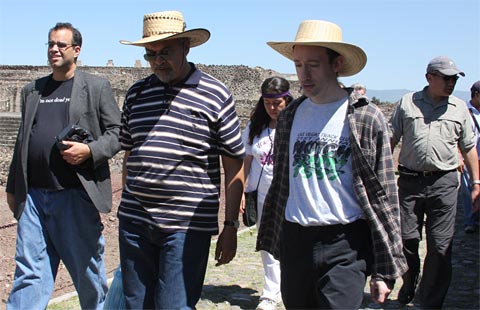
The intrepid chess reporters fully equipped for climbing the pyramids in
the Mexican sun
That's Frederic Friedel and Dennis Monokroussos in the picture above, both
very prudently wearing Mexican sombreros they had purchased for $2 each. Others,
like a Dutch journalist we know and respect, did not bother and returned from
the trip looking like a carrot. He did not sleep well that night.
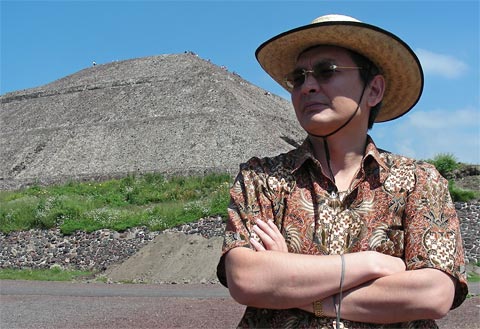
Berik Balgabaev, personal assistant to President Kirsan Ilyumzhinov, is
also ready to go
Berik is not from Kalmykia, as many people believe, but from Kazakhstan. He
met Ilyumzhinov when both were in college and has been assisting him in all
matters, but especially those related to chess, ever since. He speaks excellent
English and has a wry sense of humour, which makes him great fun to be with.
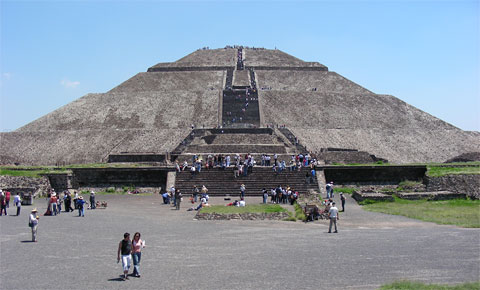
Looking back from level earth you realise where you've been and what you've
done
The Pyramid of the Sun is 738 feet across and 246 feet high, making
it the third largest pyramid in the world. Originally it was covered with lime
plaster and brilliantly adorned with colored murals, which have unfortunately
disappeared. What a spectacular sight it must have been. The pyramid has astronomical
features: it points to the setting sun on two days a year, August 12 and April
29, dates that were important in terms of both agriculture and belief systems
of the ancient society. There is a cave located six meters beneath the center
of the pyramid, which probably served as a royal tomb. Scientists have used
muon detectors to try to find other chambers within the interior of the pyramid,
but so far without success.
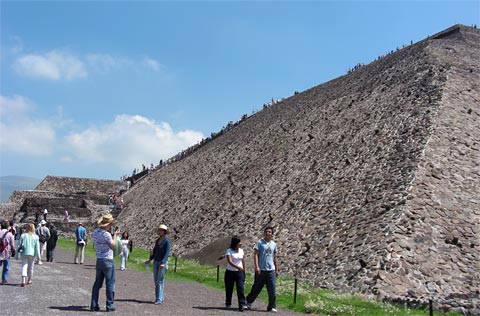
As you approach the first pyramid you realise how big they are

Visitors scaling the pyramid, which goes up higher than you can see here
At this stage we ran into a problem: our guide, a Mexican named Gerardo Roberto
Sandoval Monroy, turned out to be a Sufi
convert who called himself Said and had a passionate interest in half a dozen
other mystical and New Age philosophies.

Said announced that we would not be climbing the pyramids but visiting all
the spots where the energy of the Teotihuacán pyramids, the earth, the
moon, Venus, the solar system, the galaxy and the Universe itself converged
and could be tapped for the spiritual benefit of us visitors.
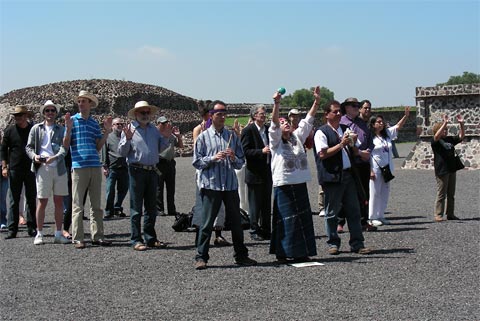
Said asked our group to build a circle, hold up their arms and face in the
four mystical directions (north, south, east and west), while he appealed to
the above mentioned forces to descend upon us. Not all the visitors followed
suit; some walked around sullenly, taking photographs and shaking their heads.

The ceremony included conch blowing, a flute and a rattle. You may recognise
Berik, Zurab and Spanish journalist Leonxto Garcia (purple shirt) in the picture
above. At this stage a policeman intervened and asked the group not to engage
in pagan rituals. He especially objected to the conch blowing. Said simply ignored
his admonitions.
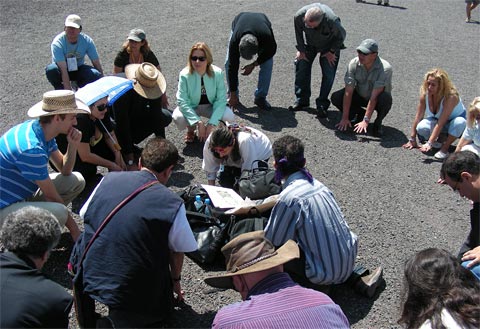
It all ended with people touching the earth to absorb the energy summoned by
the ritual. At this stage Said wished to proceed to the other energetic points
that surrounded the pyramids, but faced a rebellion by a majority of our group,
who wanted to climb the pyramids and learn more about their history, architecture,
the building technique and other mundane questions, even if it meant passing
on the energy thing.
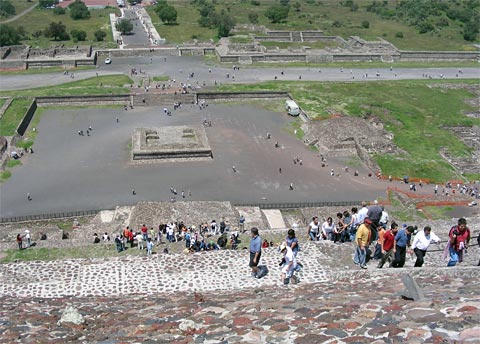
Said agreed, and climb we did – not an easy task for chess associated
people who normally maintain their fitness by castling queenside. One must mention
that some in our group were not yet fully acclimatized to the altitude of the
Mexican plateau, and that in some passages the steps were high and steep. But
most made it to the top.

After reaching the top you are rewarded with a spectacular view of the surrounding
landscape and the Moon Pyramid, to which we will proceed shortly.

As chance would have it, at the top our hero Said (who has a sense of humour
and knows that I will be writing in this vein) found a new energy focal point,
which required immediate rituals.
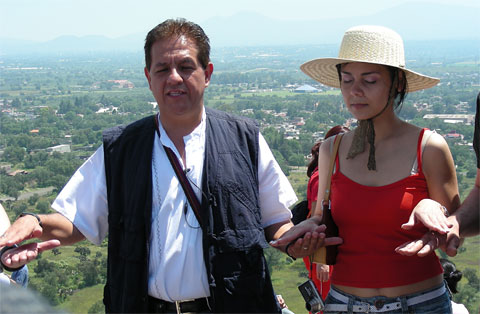
On the right is Elmira Mirzoeva, a Russian TV and radio journalist. In spite
of botching up the ritual (it's one hand facing Earth and one hand the Heavens,
Elmira!) she clearly felt the forces that flowed through her.
The Teotihuacános practiced human sacrifice, especially during the consecration
of the pyramids and other new buildings. The victims were mostly enemy warriors
captured in battle and then brought to the city to be ritually sacrificed so
the city could prosper. Said glossed over this subject, saying it was "traditional"
at the time and not practiced today. No big surprise, that one.
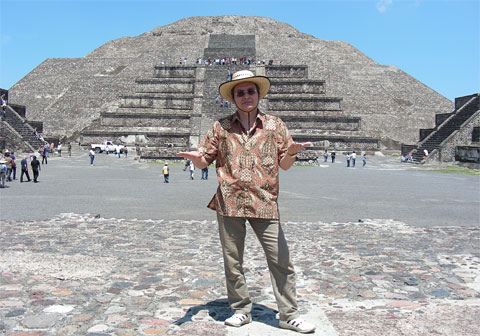
Proceeding to the Moon Pyramid Berik is eager to tap into the forces available
there

... as is the ever willing TV-and-radio-journalist Elmira
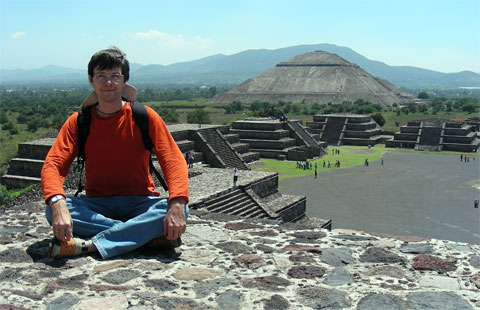
One of our ChessBase.com authors, Misha Savinov, getting in the mood

The view from the Moon Pyramid, looking towards the Sun Pyramid

... and of the main thoroughfare leading from one pyramid to the other
The broad central passage is called "Avenue of the Dead" ("Miccaotli")
and is flanked by impressive ceremonial architecture. It is also filled with
vendors trying to sell you blankets, obsidian statues, bracelets, masks, and
other trinkets, all at just a 50% markup when compared to stores in Mexico City.

A fresco with the original colours still intact...

...and an explanation thereof [click to enlarge the text]

A modern-day denizen seeking contact with the passengers on the bus ride
back to the hotel. It paid with its life for its wholly inappropriate intentions.
We were told that there might be general problems in Mexico with mosquitoes,
but the Sheraton Hotel is perfectly insulated and we are yet to encounter one
of these horrid little pests in our living quarters.

Talking about bugs: look what was on the menu that evening: cactus caterpillars
in the sea-food ceviche. They were edible (of course we did!), though not particularly
delicious or addictive.
Photos by Frederic Friedel
Links
















































